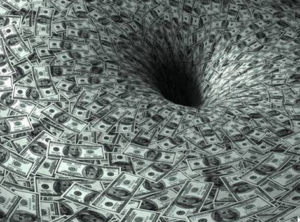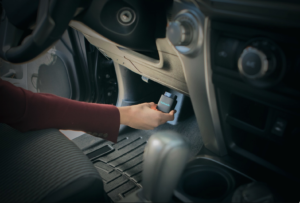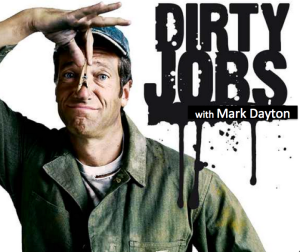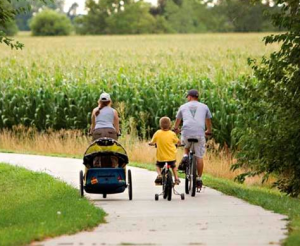Imagine you discovered your salary was going to be steadily declining in the coming years, making it impossible for you to fund future needs. Would you shrug off this news, and passively accept the associated damage, or shift to a more stable source of income?
When it comes to the funding needed to build and maintain the nation’s roads and bridges, policymakers are facing a similar threat, and most of them are shrugging it off.
The Problem
Currently, we finance much of our transportation infrastructure with a state and federal gasoline tax, where the more gasoline we use, the more we contribute to building and maintaining the transportation infrastructure. For a long time, the gas tax has served us well.
 But the gas tax is becoming obsolete. Here’s why: Between 2008 and 2014, the average fuel efficiency of new cars increased by 22%. In coming years, new fuel efficiency regulations and technological improvements will accelerate that progress. As as result, by 2040 the U.S. Energy Information Administration (EIA) projects that fuel sales will decrease by between 34% and 45%. The less gasoline we use, the less we have for building and maintaining our transportation infrastructure.
But the gas tax is becoming obsolete. Here’s why: Between 2008 and 2014, the average fuel efficiency of new cars increased by 22%. In coming years, new fuel efficiency regulations and technological improvements will accelerate that progress. As as result, by 2040 the U.S. Energy Information Administration (EIA) projects that fuel sales will decrease by between 34% and 45%. The less gasoline we use, the less we have for building and maintaining our transportation infrastructure.
“Just raise the gas tax,” you say? Well, a paper recently written by transportation finance expert Ed Regan estimates:
“If governments want to still generate equivalent revenue to keep up with future travel levels, gas tax rates will need to be increased to as much as $1.16 per gallon to overcome the effect of future fuel efficiency.”
Given how politically difficult it has proven over the years to increase the gas tax by even a few pennies, an increase of that magnitude would seem to be politically impossible.
Even if passing such a huge increase were somehow politically feasible, we would be left with a grossly unfair system where some can avoid, quite legally, paying their fair share for funding roads and bridges. (By the way, as someone who has driven a gas-electric hybrid for a decade, I’m one of those people unfairly benefiting from the gas tax status quo.)
If we don’t enact a steep gas tax, Regan has alarming numbers for policymakers and citizens to ponder:
By 2025, just 8 years from now, increasing fuel efficiency may cost state and federal coffers as much as $20.8 billion per year in fuel tax revenues.
Twenty-one billion dollars is a lot of road and bridge projects. Clearly, stubbornly clinging to the gasoline tax status quo would dramatically impact our safety, global competitiveness and quality-of-life.
Yes, the Trump administration is proposing to roll back fuel efficiency standards. But many experts believe this will have only a limited effect on the trend toward greater fuel efficiency and use of non-gasoline powered vehicles. CNBC reports:
Trump’s bid to ease fuel efficiency rules will be tough and likely limited, experts say:
The White House’s attempts to alter the Obama administration’s plan to raise federal automobile fuel standards could be a slog and ultimately yield little change, experts say.
The Department of Transportation and the Environmental Protection Agency will revisit rules finalized under President Barack Obama that would keep automakers on pace to manufacture vehicles that get more miles per gallon. But experts say it will be difficult for President Donald Trump to meaningfully relax the rules under the Corporate Average Fuel Economy standards, or CAFE.
Whether driven by consumer demand, regulations or both, the march towards greater fuel efficiency seems inevitable. The Trump fuel efficiency changes may slow the march, but they won’t stop or reverse it.
The Solution
The most logical solution to this increasingly urgent problem is to charge users based on distance traveled rather than gasoline used. Under such an approach, transportation funding would be much more adequate and stable than it is with the gas tax.
 But in the stodgy world of transportation finance, old habits die hard. Charging based on distance requires a very different type of revenue collection system, and such a change is proving to be mind-bending for many policymakers.
But in the stodgy world of transportation finance, old habits die hard. Charging based on distance requires a very different type of revenue collection system, and such a change is proving to be mind-bending for many policymakers.
Fortunately, at the state level various approaches are being piloted, evaluated and refined. For instance, one approach being tested with 5,000 volunteers in California gives users a range of choices for collecting a “Road User Charge.” Volunteers can choose to track distance by using 1) a small electronic device, called a “dongle,” plugged into their vehicle, 2) a smart phone photo of their odometer sent to authorities on a monthly basis, or 3) other more low-tech tracking methods.
Moving to this type of distance-based system won’t come without headaches or expense. But everything is relative, and accepting the hassles associated with this transition is a small price to pay for avoiding a transportation infrastructure meltdown. With as much as $21 billion in transportation funding about to disappear over just the next eight years, and much more about to disappear in the coming decades, policymakers can no longer afford to shrug off this problem.
Note: I have done public relations work on this issue for an academic client, but the views expressed are my own.

 Governor Mark Dayton is Minnesota’s political version of Mike Rowe, the star of the Discovery Channel television show “Dirty Jobs.” Rowe’s show is all about him taking on difficult, disrespected and grotesque jobs that others avoid, such as being a sewer inspector, road kill scavenger, worm dung farmer, shark repellent tester, maggot farmer, and sea lamprey exterminator. Who knew that worm dung needed farming?
Governor Mark Dayton is Minnesota’s political version of Mike Rowe, the star of the Discovery Channel television show “Dirty Jobs.” Rowe’s show is all about him taking on difficult, disrespected and grotesque jobs that others avoid, such as being a sewer inspector, road kill scavenger, worm dung farmer, shark repellent tester, maggot farmer, and sea lamprey exterminator. Who knew that worm dung needed farming? Minnesota Republicans captured control of the Minnesota House of Representatives in part by fueling urban versus rural resentment: “Those metro-centric DFLers give everything to Minneapolis and St. Paul.” The truth is, turnout trends associated with non-presidential year elections were a
Minnesota Republicans captured control of the Minnesota House of Representatives in part by fueling urban versus rural resentment: “Those metro-centric DFLers give everything to Minneapolis and St. Paul.” The truth is, turnout trends associated with non-presidential year elections were a